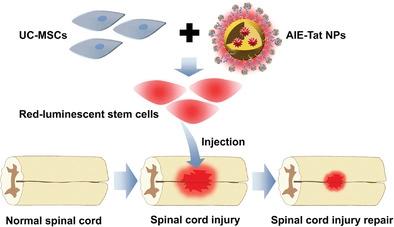当前位置:
X-MOL 学术
›
Adv. Therap.
›
论文详情
Our official English website, www.x-mol.net, welcomes your feedback! (Note: you will need to create a separate account there.)
Umbilical Cord Mesenchymal Stem Cells Promoting Spinal Cord Injury Repair Visually Monitored by AIE-Tat Nanoparticles
Advanced Therapeutics ( IF 4.6 ) Pub Date : 2022-09-14 , DOI: 10.1002/adtp.202200076 Peigen Xie 1, 2, 3 , Haiqian Ling 1, 2, 3 , Mao Pang 1, 2, 3 , Lei He 1, 2, 3 , Zeyan Zhuang 4 , Guiling Zhang 5 , Zihao Chen 1, 2, 3 , Chuanggui Weng 1, 2, 3 , Sijin Cheng 1, 2, 3 , Ju Jiao 5 , Zujin Zhao 4 , Ben Zhong Tang 6 , Limin Rong 1, 2, 3
Advanced Therapeutics ( IF 4.6 ) Pub Date : 2022-09-14 , DOI: 10.1002/adtp.202200076 Peigen Xie 1, 2, 3 , Haiqian Ling 1, 2, 3 , Mao Pang 1, 2, 3 , Lei He 1, 2, 3 , Zeyan Zhuang 4 , Guiling Zhang 5 , Zihao Chen 1, 2, 3 , Chuanggui Weng 1, 2, 3 , Sijin Cheng 1, 2, 3 , Ju Jiao 5 , Zujin Zhao 4 , Ben Zhong Tang 6 , Limin Rong 1, 2, 3
Affiliation

|
Spinal cord injury (SCI) is a severe body trauma that can cause permanent loss of somatic nerve function and lacks effective treatment. Transplantation of stem cells is a promising therapeutic approach for SCI but faces with the difficulty of long-term tracking of stem cells in vivo precisely. Herein, this work wishes to report a kind of umbilical cord mesenchymal stem cells (UC-MSCs) labeled with aggregation-induced emission (AIE)-Tat nanoparticles (NPs) for tracing the repair and treatment of SCI. These AIE-Tat NPs have strong fluorescence, good biocompatibility, and long-term tracking ability with a high signal-noise ratio. The labeling of AIE-Tat NPs does not induce adverse effects on the activity and performance of UC-MSCs. The fluorescence signal of the UC-MSCs can be monitored for up to 28 days, reflecting the viability, colonization, and function of the transplanted UC-MSCs. The transplantation of UC-MSCs can secrete nerve growth factors and maintain the viability of cells in the highly reactive oxygen species microenvironment, leading to effective recovery of injured spinal cord, which is further confirmed by the behavioral rehabilitation and histopathological results. These findings demonstrate that long-term tracking of UC-MSCs labeled with AIE-Tat NPs is a promising method to monitor stem cell transplantation therapy for SCI.
中文翻译:

AIE-Tat纳米颗粒视觉监测脐带间充质干细胞促进脊髓损伤修复
脊髓损伤(SCI)是一种严重的身体创伤,可导致躯体神经功能永久丧失,且缺乏有效治疗。干细胞移植是一种很有前途的脊髓损伤治疗方法,但面临着在体内长期精确追踪干细胞的困难。在此,这项工作希望报告一种标记有聚集诱导发射 (AIE)-Tat 纳米颗粒 (NPs) 的脐带间充质干细胞 (UC-MSCs),用于追踪 SCI 的修复和治疗。这些AIE-Tat NPs具有强荧光、良好的生物相容性、长期跟踪能力和高信噪比。AIE-Tat NPs 的标记不会对 UC-MSCs 的活性和性能产生不利影响。UC-MSCs 的荧光信号可以监测长达 28 天,反映活力、定植、和移植的 UC-MSCs 的功能。UC-MSCs的移植可以分泌神经生长因子,维持细胞在高活性氧微环境中的活力,导致损伤脊髓的有效恢复,行为康复和组织病理学结果进一步证实了这一点。这些发现表明,长期跟踪用 AIE-Tat NPs 标记的 UC-MSCs 是监测 SCI 干细胞移植治疗的有前途的方法。
更新日期:2022-09-14
中文翻译:

AIE-Tat纳米颗粒视觉监测脐带间充质干细胞促进脊髓损伤修复
脊髓损伤(SCI)是一种严重的身体创伤,可导致躯体神经功能永久丧失,且缺乏有效治疗。干细胞移植是一种很有前途的脊髓损伤治疗方法,但面临着在体内长期精确追踪干细胞的困难。在此,这项工作希望报告一种标记有聚集诱导发射 (AIE)-Tat 纳米颗粒 (NPs) 的脐带间充质干细胞 (UC-MSCs),用于追踪 SCI 的修复和治疗。这些AIE-Tat NPs具有强荧光、良好的生物相容性、长期跟踪能力和高信噪比。AIE-Tat NPs 的标记不会对 UC-MSCs 的活性和性能产生不利影响。UC-MSCs 的荧光信号可以监测长达 28 天,反映活力、定植、和移植的 UC-MSCs 的功能。UC-MSCs的移植可以分泌神经生长因子,维持细胞在高活性氧微环境中的活力,导致损伤脊髓的有效恢复,行为康复和组织病理学结果进一步证实了这一点。这些发现表明,长期跟踪用 AIE-Tat NPs 标记的 UC-MSCs 是监测 SCI 干细胞移植治疗的有前途的方法。



























 京公网安备 11010802027423号
京公网安备 11010802027423号